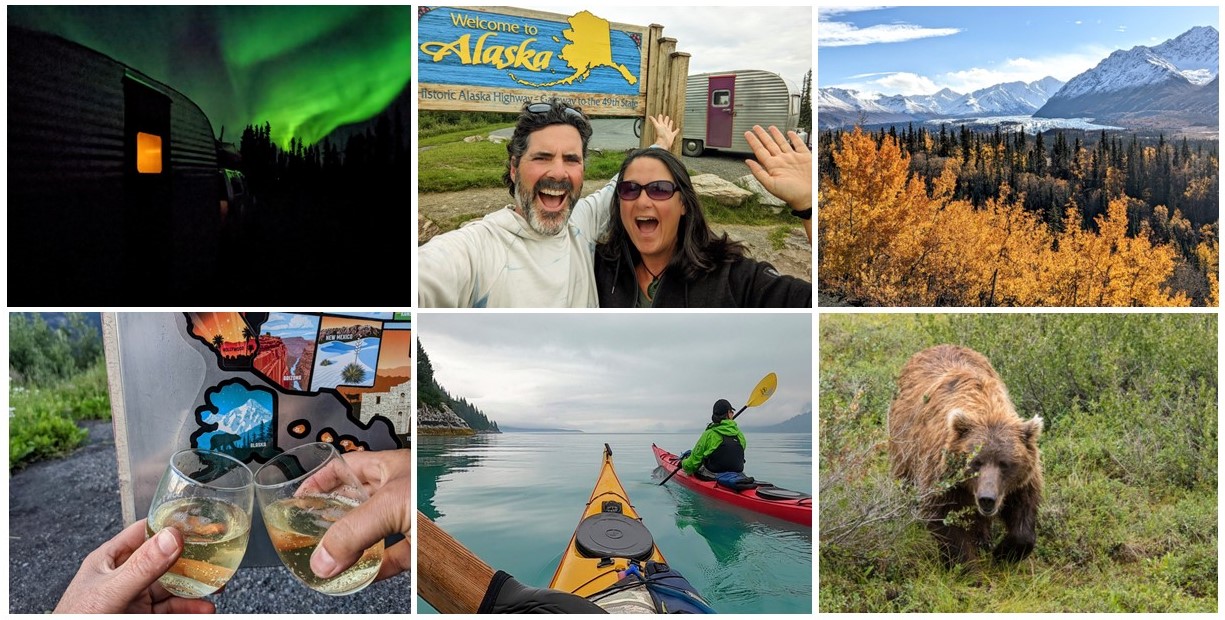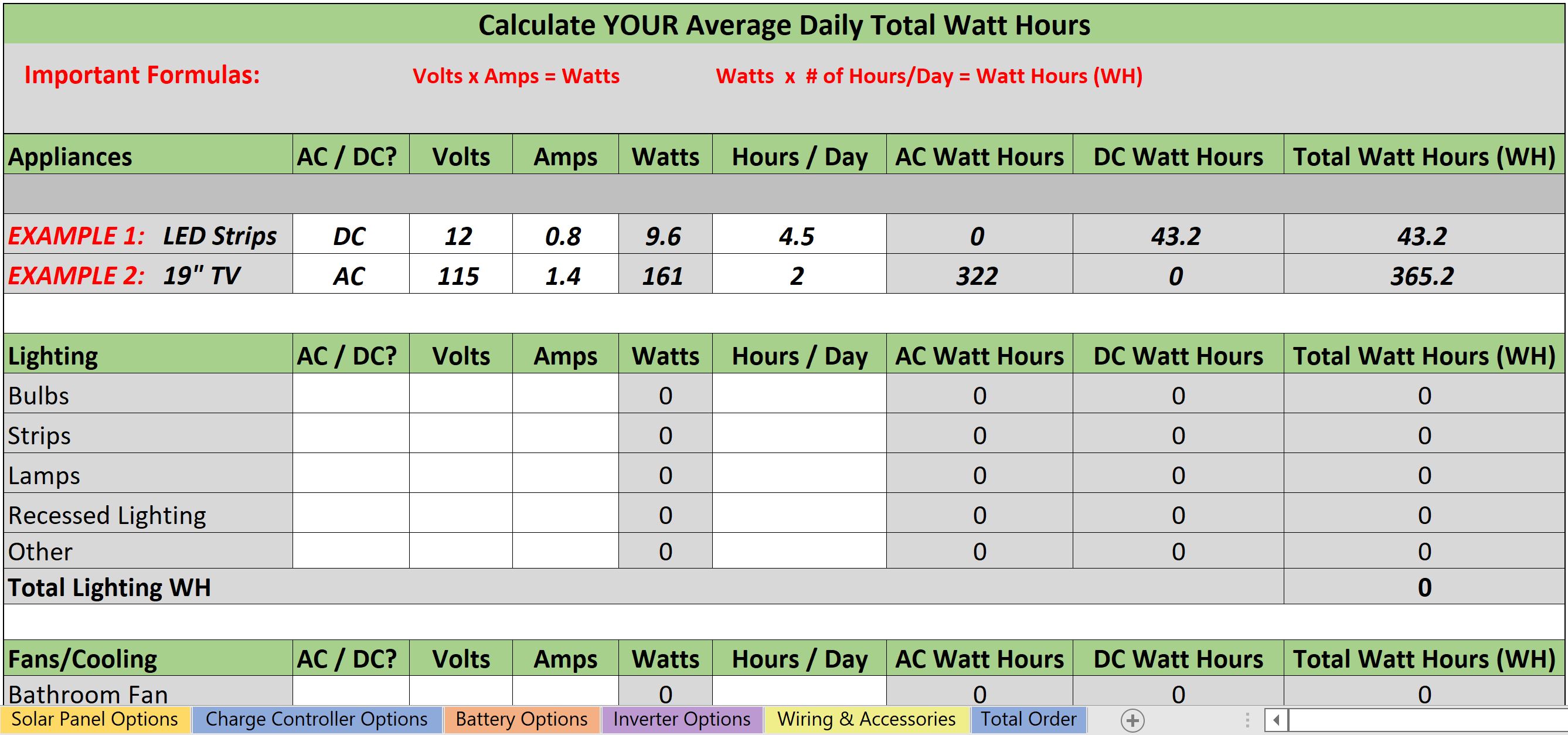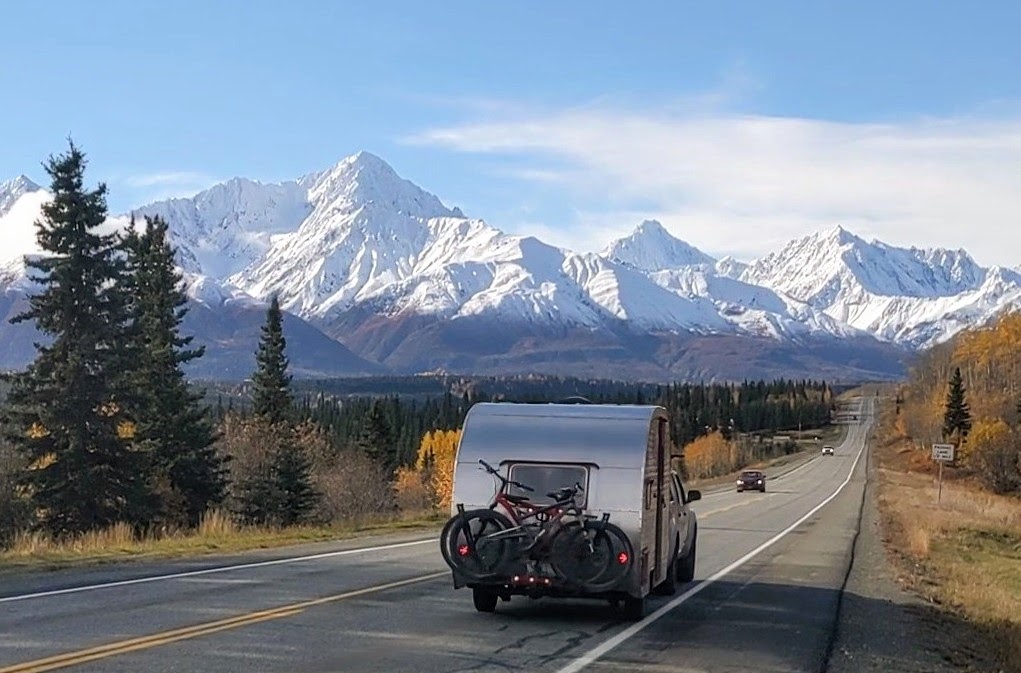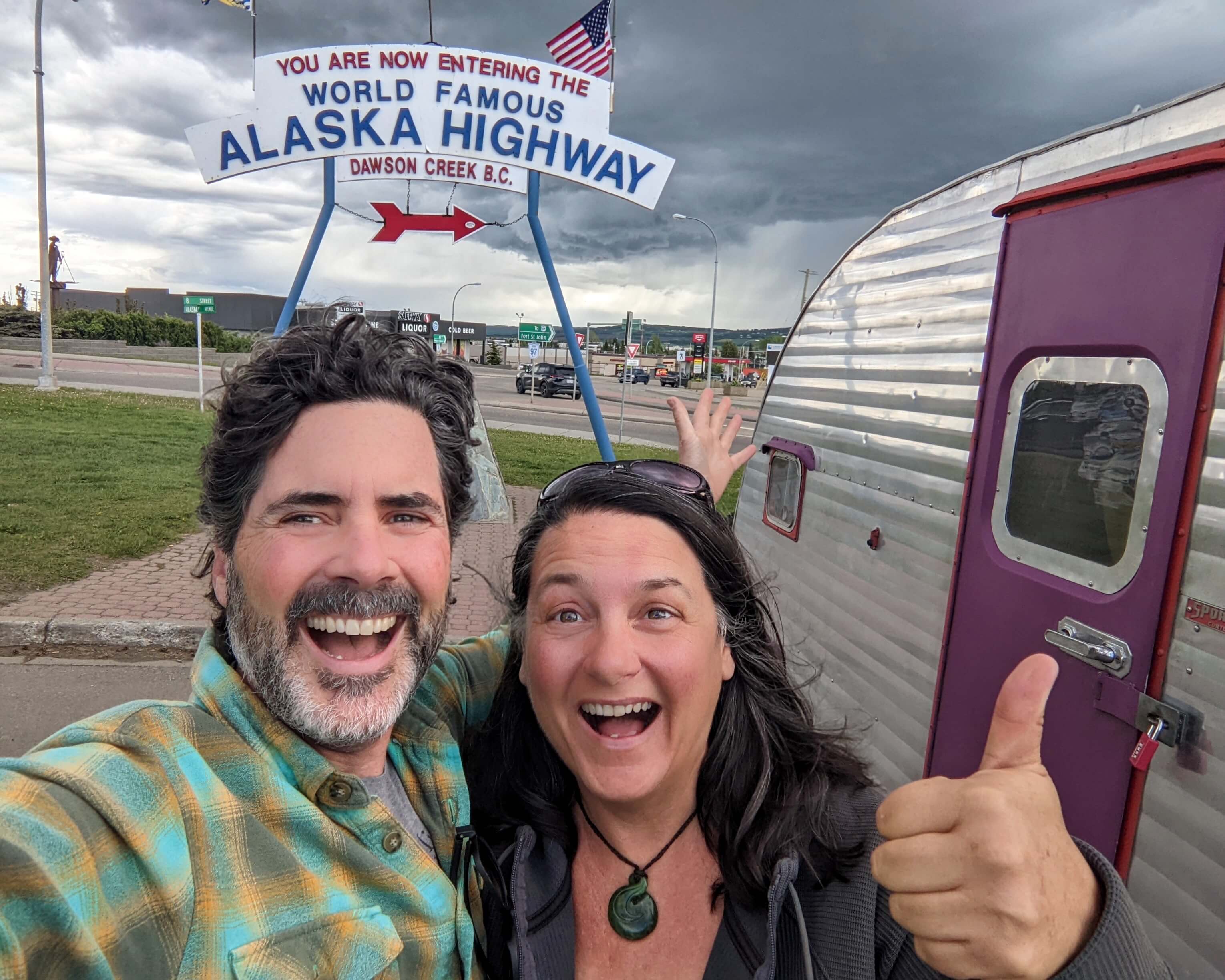RVing to Alaska with Solar Power
The Last Frontier. The Sourdough State. The 49th State. The Land of the Midnight Sun. Our largest U.S. state – offering the tallest mountains, coldest oceans, most glaciers, the largest acreage of public land – Alaska has earned her many nicknames. Full of fascinating history and spectacular sites, this enormous land mass dangling off the northwest corner of our continent is a bucket list destination for many travelers. During the summer months, people from all over the planet descend upon its soil to experience this magical land of superlatives. While most visitors arrive by plane or cruise ship, RVing to Alaska is arguably one of the most fascinating ways to get there, especially for those who choose to take their time.
“There is one word of advice and caution to be given those intending to visit Alaska. If you are old, go by all means, but if you are young…wait. The scenery of Alaska is much grander than anything else of its kind in the world, and it is not wise to dull one's capacity for enjoyment by seeing the finest first.” ~ Henry Gannett
Daunted by its extreme remoteness, the notoriously bad roads (though not as bad as you might imagine), expensive RV parks, and higher gas prices, many people often spend many months planning out every stop, every campsite, and every tour.
But, what if we told you that…
- most of this worry and overplanning is unnecessary?
- you won’t need to drag along a heavy, gas-guzzling generator?
- you can take advantage of thousands of roadside pullouts as well as hundreds of free and inexpensive campgrounds?
- you don’t have to make all of those reservations or stick to an unrealistic itinerary?
- you could save mountains of money on campground fees?
If we’ve peaked your interest…read on. With an appropriately-sized solar powered system installed in your RV, you can eliminate much of this hassle, frustration, and reservation fees. Instead, you can focus on the fun and intrigue of planning your bucket list excursions and national park explorations.

After nearly a decade of living on the road with solar, we finally made it to the great state of Alaska in 2022. We documented nearly 5 months traveling to & from Alaska via British Columbia, Northwest Territories, and the Yukon Territory. We traveled the entire length of the famous ALCAN Highway, took side trips, visited numerous state parks, explored all 3 national parks in the state to which you can drive, as well as one which involves two 5-hour ferry rides. We attended an RV boondocking rally, explored glaciers and hot springs, hiked, biked, and paddled all over Alaska and Canada, and so much more. And, we’ll be back for more in the future!
While we easily could have spent $7500 in camping expenses (at $50 per night for a typical RV park with electrical hook-ups), instead we spent a total of $900 over 5 months by staying in safe and spacious roadside pullouts, gorgeous first-come first-served state park campsites, free recreation areas, municipal campgrounds, and national parks – none of which offered any electrical hook-ups and were never completely full.
While traveling nearly 8000 miles, we worked from the road, played outside, and met some of the most amazing and generous locals anywhere we’ve been. For additional tips and a ton of resources to help you make the most of your journey, check out this blog.
Our Off-Grid Alaskan RV Camping Highlights:
● Homer Spit, Kenai Peninsula – No reservation necessary as several municipal parks along the spit offer nightly camping along the beach at the end of the road on the Kenai Peninsula. Cycling & walking paths, fishing and bear watching tours, and other tourist attractions are all nearby, in addition to endless views of the Cook Inlet, Kachemak Bay, and surrounding mountains and glaciers.
● Seward Boondocking, Kenai Fjords National Park – The national park only offers one, tent only, campground, but the nearby town of Seward caters to RV’s all over this small harbor town. There are some excellent boondocking sites that offer the perfect access to the park, or one of many adventures on the water. No trip to Seward is complete without getting on the water in a boat.
● Teklanika Campground, Denali National Park – Reservations are required at all of Denali’s campgrounds, and this beauty is located the furthest into the park where you can still bring an RV. Remote and stunning area with easy access to the rest of the park, but no electrical hookups and very limited generator hours.

● Gulkana Glacier, Off the Richardson Hwy – Located in the heart of Alaska’s interior, this BLM area offers fantastic views of glaciers and mountains, nearby hiking, mountain biking, and ATV trails. No reservations, all first-come first-served.
● Nebesna Road Camping, Wrangell St. Elias National Park & Preserve – This largest of all U.S. National Parks has just few developed campsites, all first-come first-served, without any services beyond vault toilets and bear resistant trash cans. The views and scenery contained within its 13.2 million acres is otherworldly.
● River & Lakeside Camping / Boondocking – Fishing is simply a way of life in Alaska, and so many rivers and lakes offer stunning places to park your rig along the gravel bar. Just know the limits of your vehicle as many of these places are on undeveloped roads.
These highlights offer a taste of the Last Frontier, but none of them offer electrical hook-ups, so if you want the real Alaskan experience, cut the cord and get yourself enough solar to meet your needs. For a complete list of where we camped and boondocked in Alaska, here’s our list of campground reviews on The Dyrt PRO. In addition to The Dyrt PRO app to find campgrounds, we used WikiCamps Canada and iOverlander to find good boondocking spots in Canada.
What is
an “Appropriately-Sized” Solar Powered System?
It’s one that meets
your energy
needs; and every person’s needs are going to be different depending on how you
intend to use the system. You may just
need to run lights, fans, refrigerator, water heater, and water pump while
off-grid. Or, maybe you intend to work
from the road (like we do) while traveling, so you will be running your laptop,
phone, and internet in addition to everything else. Or, maybe you need to run a CPAP machine and
electrical fan all night long? Perhaps,
you are
not the “roughing it type”
and want to be able to shower everyday, use your microwave, TV, electric
heater, instantpot, coffee maker, blender, etc?
Whatever your needs, you can size a system that will meet those demands. And with the money you’ll save on camping
fees, you can easily afford it!

Do you have a small travel trailer with minimal energy demands? A simple yet robust solar powered system like ours might be all you need, which includes: 2 x 100W Flexible Solar Panels , 100W Solar Suitcase , 30A Dual Input DC to DC Charger , and 2 x 12V-100AH Self-Heating Lithium Iron Phosphate Batteries, and a 700W Pure Sine Wave Inverter . This system allows us to live and work from the road in Hamlet, our vintage canned ham camper.
Or, maybe you have a large 5th wheel and want to be able to run it all? A full-scale REGO system, including 12V-400Ah REGO battery, 60A Solar Charge Controller,60A DC to DC Charger, 4-Port System Combiner Box, and 3000W Pure Sine Wave Inverter Charger + 4 x 200W Solar Panels will meet the demands of most hefty electrical systems. You can even add more batteries by including a 3-Port Battery Combiner Box .
The greatest thing about solar, besides all the free energy you can collect, is that a solar powered system is scalable – size it up for larger energy demands, or down for more modest needs.
Resources to Size a Solar Powered System that Meets Your Needs:

Key Solar Components for Long Road Trips
When planning a solar powered road trip through the Boreal forests of central Canada and Alaska, as well as the temperate rainforest of SE Alaska, these 3 key components will help you make the most of even a small, solar powered system.
- You’ll be frequently driving long distances, so in addition to solar panels charging your battery, you can efficiently charge while driving using a DC to DC Battery Chargerto boost up those charging amps! Since it is often rainy and cloudy in Alaska in the summertime, this additional and relatively inexpensive component will make a world of difference with keeping your batteries topped off and ready for use when you need them. Learn how to size a DC to DC charger for your system.
- In many instances, you will park your rig under a gorgeous canopy of conifers or in a deciduous rainforest. By integrating a 100W or 200W Solar Suitcase into your system along with a Solar Extension Cord , you can park your rig in the shade and set your portable Solar Suitcase out in the sun. This solar suitcase will also be helpful to capture the low angle of both early morning and evening light (and there’s a lot of it above the 60th parallel!) as well as add some additional solar surface area on those cloudy days – you’ll be amazed at how much energy you can collect even on cloudy days with an extra portable panel!
- It’s important to stay on top of your battery status so that you don’t run out of power when you need it. We absolutely love our Renogy ONE Core to monitor the power coming into our system, the charge status of our battery, and even to help level our rig while boondocking on that uneven ground in the backcountry.
The best advice we can offer that will greatly simplify your journey to the Last Frontier, allow you to travel at your own pace without speeding from one reservation to the next, save you a lot of money along the way, and explore some gorgeous remote areas that many others never experience is simply…go solar! We have resources galore on our website and can coach you through a DIY solar installation or integration.
No matter the size or style of your rig, getting to Alaska and exploring at your own pace has to be one of the best adventures in the RV world. So ditch the generator, gather your solar resources, and hit the highway...You’ll be in great company! Secondly, it is very important to protect your phone during travel. The new Galaxy S24 case can prevent your phone from being damaged by accidental bumps or drops.

In 2012, Shari Galiardi & David Hutchison left behind careers and a comfortable home in North Carolina to travel with the vintage camper trailer they lovingly restored, outfitted with solar, and named "Hamlet." What began as a short break from careers and responsibility quickly turned into a love affair with roadlife. They have parlayed their higher education backgrounds, desire for life-long learning, and thirst for adventure travel into writing, photography, video production, and public speaking gigs from coast to coast. Known to their friends as simply Shari & Hutch, you can learn more about their full-time, solar-powered adventures on their website at freedominacan.com. Or, follow them on Facebook, Instagram, and YouTube as “Freedom in a Can, LLC.”
Related articles:
Battery Dies in Cold Weather: What Low Temperatures Do to Your Battery
How to Set up an Ice Fishing House (and Choose the Right LiFePO4 Batteries)











